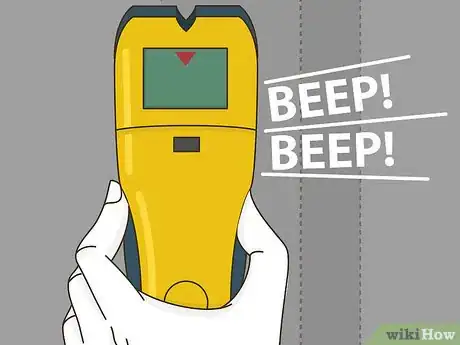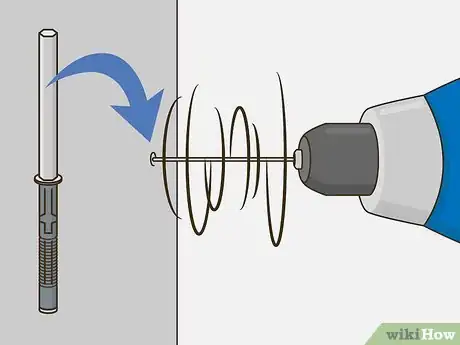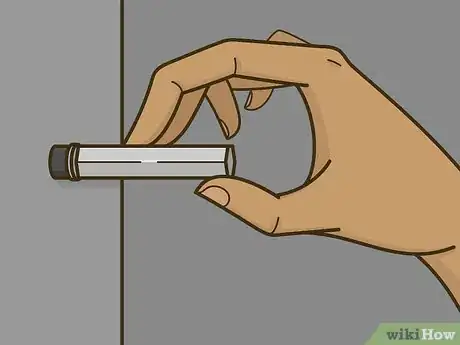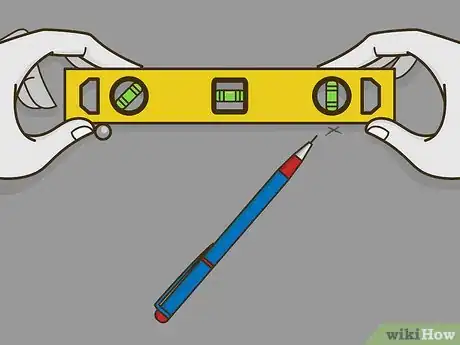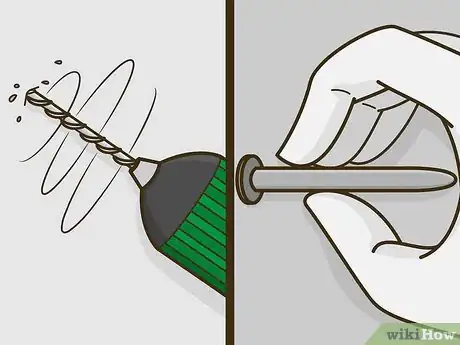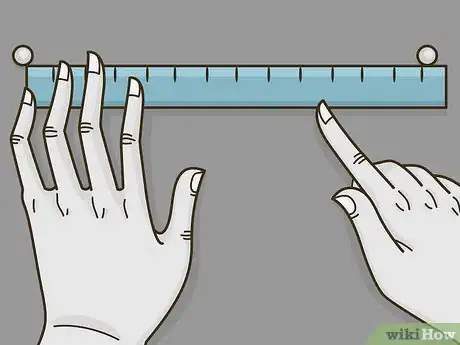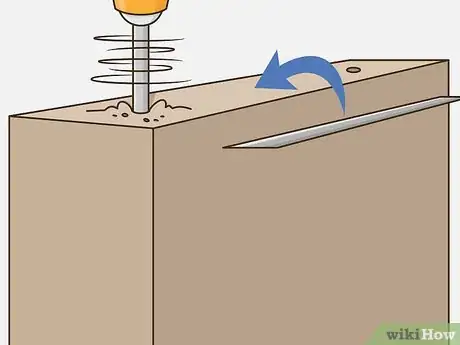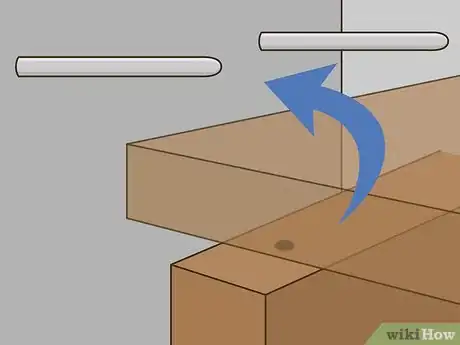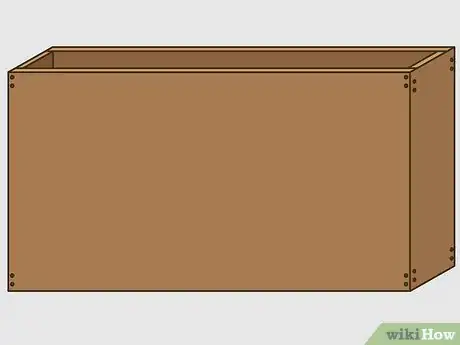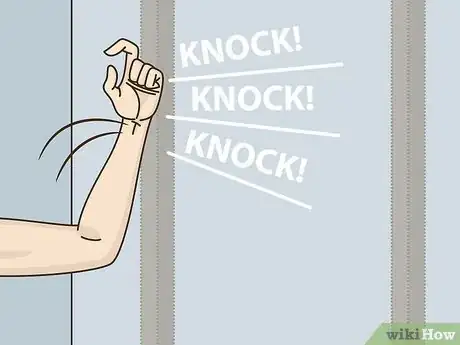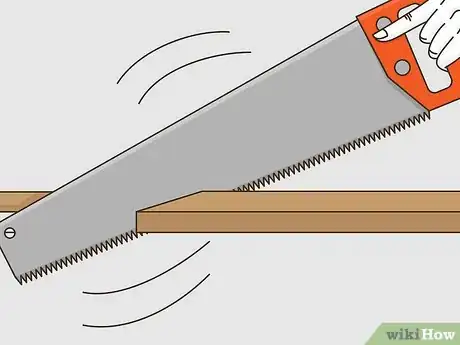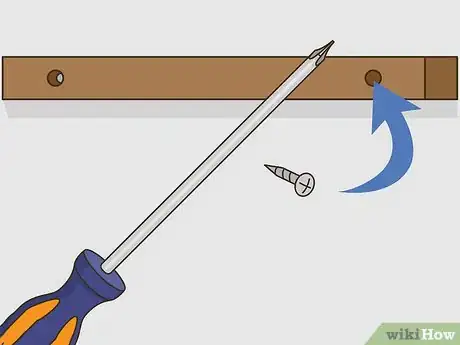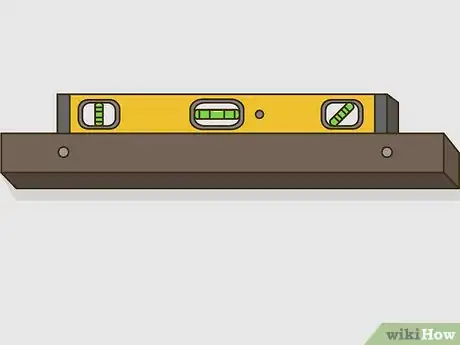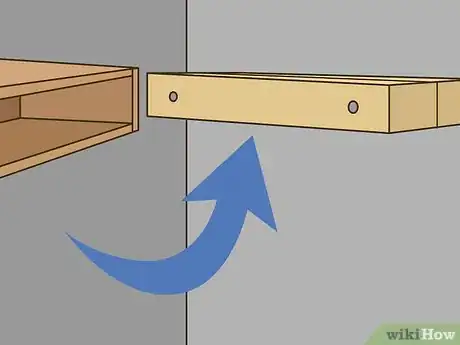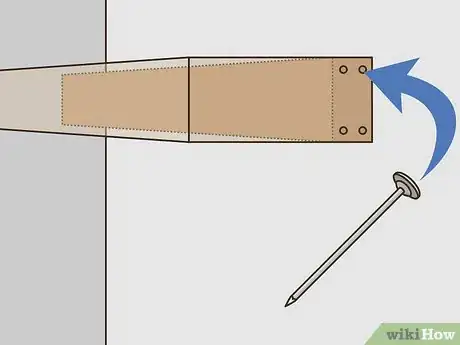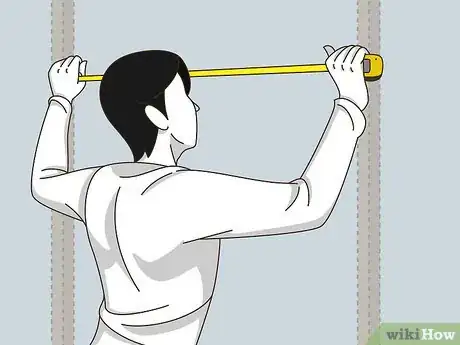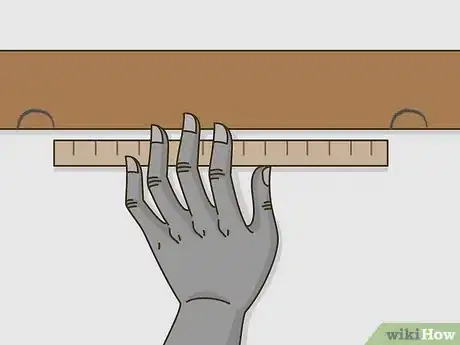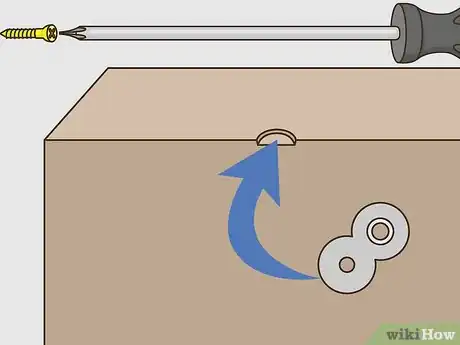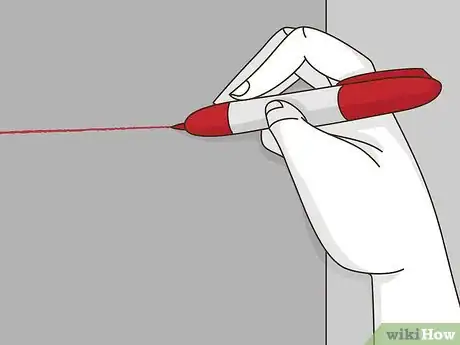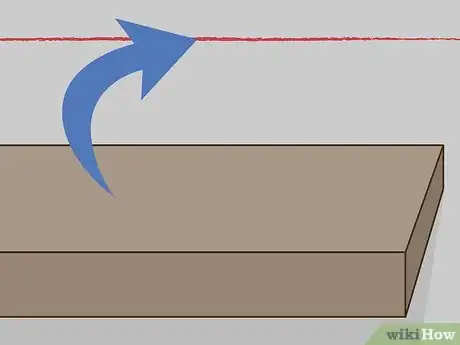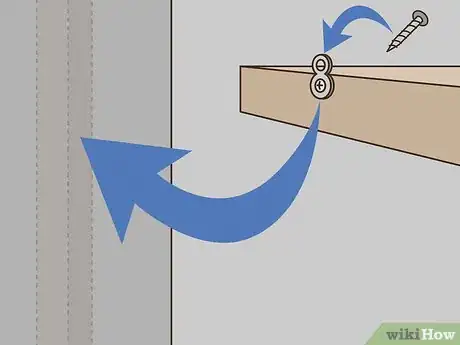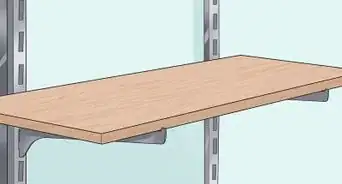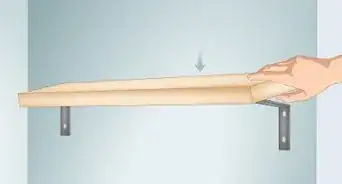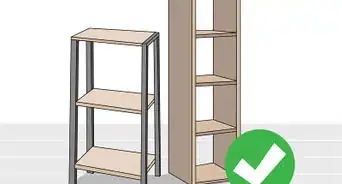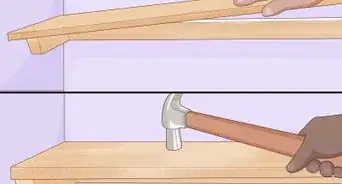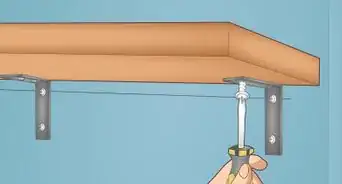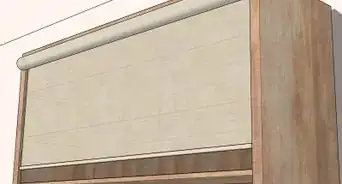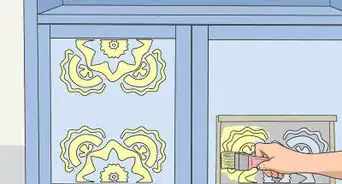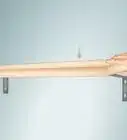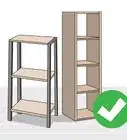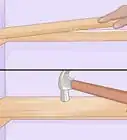This article was co-authored by Jason Phillip. Jason Phillip is a handyman specializing in mounting and hanging objects onto walls. With over five years of experience professionally mounting and installing objects through his company, Jason's Handyman Services, Jason's work includes working with mounting window AC units, designing art gallery walls, installing kitchen cabinets, and replacing light fixtures on drywall, brick, and plaster. He has been rated a "Top Pro" every year since 2016 by Thumbtack for being one of the highest-rated, most popular professionals on Thumbtack.
This article has been viewed 362,955 times.
There are several ways to hang your floating shelves using different types of hardware. You can choose to use brackets specifically designed for floating shelves, making them invisible to the eye. You can also build your own hollow shelf and then slide it right on to a wooden cleat. Lastly, there's the option of using figure-eight fasteners to hold your shelf up on the wall.
Steps
Using Floating Shelf Brackets
-
1Use a stud finder to find the studs in the wall. The best way to do this is to use a stud finder, sliding it along the wall horizontally until the stud finder indicates where the stud is. Once you’ve located the studs, use a pencil to mark where they are.[1]
- You can also try to find the studs by looking for small dimples in the trim or knocking on the wall and listening for a solid sound instead of a hollow one.
-
2Use a drill to drill into the stud where you’d like to hang your shelf. To create the first hole for your special bracket, use a 0.25 inches (0.64 cm) drill bit to get started. Once you’ve created a small hole, switch to a 0.5 inches (1.3 cm) bit and drill a hole for the bracket, making sure not to drill too deep.
- You can measure the bracket’s length and then use a piece of tape to mark the drill bit so that you don’t drill too far in.
Advertisement -
3Secure the bracket in the hole. Place the bracket in the hole, turning it until you feel a slight resistance. Keep turning the bracket until it feels tightly secured.
- If you’re twisting the bracket and aren’t feeling any resistance, pull it back out. Twist the end that goes into the shelf clockwise so the bracket expands.
-
4Use a level to place the second bracket. To make sure your shelf is even and steady, use a level and the stud finder to decide where to place the other bracket that will hold up your shelf. Use a pencil to mark where the second bracket will go.[2]
- Make sure the distance between the 2 brackets isn't longer than the length of your shelf.
-
5Install the second bracket using a drill and secure it tightly. Follow the same process of drilling a hole into a stud using the drill bits. Place the bracket into the second hole, twisting it until it’s tightly secured.
- Remember not to drill too deeply when making the hole for the bracket.
- It’s a good idea to use the level again once you’ve placed the second bracket, just to make sure the 2 brackets create a level surface.
- If the brackets aren't level, you'll need to remove 1 from the wall and realign it.
-
6Measure the distance between the 2 brackets carefully. Use a ruler to measure the distance from 1 bracket to the next so that you’ll know where to drill the holes in your shelf. You need this measurement to be exact, so take the time to measure it 2 or 3 extra times. Write down the measurement so that you don’t forget it.
-
7Drill the bracket holes into your shelf. Use your bracket measurements to draw dots on the back of your shelf where the holes will go using a pencil. Make sure the holes are straight and level with each other. Carefully drill the 2 holes into the wood — use a drill press to create the holes, if possible.[3]
- If you don’t have a drill press, you can create a jig to hold the wood. Keep your wood from moving by putting pieces of wood on either side of it with a thin slab nailed on top.
- Mark the depth with tape to ensure you’re not drilling too far.
- Measure your shelf to make sure it's the right thickness and depth for the brackets you chose. The specifications for the brackets should be labeled on the package they come in.
-
8Slide the shelf onto the brackets. Clear out any dust from the holes in the shelf and slide it onto the brackets installed in the wall. You should have a nice, clean fit. Use a level to check to make sure the shelf is even.[4]
Installing Cleats
-
1Build your own floating shelves so that they’re hollow. There are a couple of ways to do this, but the easiest way is to use plywood and nails to create a hollow shelf. You would ultimately have 5 sides, with the back of the shelf being open.[5]
- You want your shelf to slide onto a cleat, which is why the shelf won’t have a back.
-
2Decide where to install the cleat by locating the studs. Use a stud finder to figure out where your wall studs are, and then mark where you’d like to install the cleat to hold your shelf.[6]
- Try to hit at least 2 wall studs per shelf for the best stability.
-
3Cut a 2x2 piece of wood long enough to fit inside your floating shelves. This section of wood will be what the open back part of your shelf slides onto to keep it on the wall. Measure the piece of wood to ensure it fits inside the length of the shelf before using a saw to cut it.[7]
- You can also take the piece of wood to a home improvement store to have them cut it for you.
-
4Use screws to secure the cleat to the wall. Attach the cleat to the wall using 3 in (7.6 cm) screws. Use 2-3 screws, depending on the length of your shelf.[8]
- Try to install the screws into the studs, or use heavy anchor fasteners.
-
5Check to make sure the shelf is even before tightening the screws. Use a level to see that both screws create an even surface. Tighten the screws to ensure the cleat is safely attached.[9]
-
6Add an additional 2x2 section of wood for wide shelves, if desired. If the shelf you’re installing is very wide, you might want your cleat to stick out a bit more. Attach another 2x2 piece of wood of the exact same length on top of the first one using screws. This will give your cleat more depth.[10]
-
7Push the shelf onto the cleat. Center your shelf on the cleat and push it back against the wall into place. Your cleat should fit in your hollow shelf snugly.[11]
- If your shelf isn't super snug or feels a bit loose, try adding an additional 2x2 piece of wood for better security.
-
8Secure the shelf to the cleat with nails or screws. As an additional precaution, you can hammer in some nails to make sure your shelf doesn’t move from the cleat. Pick a place that won’t be seen easily, like the very top of your shelf if it’s placed up high, or the bottom of the shelf if it’s placed low.[12]
Placing Figure-Eights
-
1Locate the studs in the wall. You’ll need to find out where the studs are in the wall so that you can drill into them. Using a stud finder is the easiest way of figuring out where the studs are, but there are also other ways of finding a stud.[13]
- If you can’t find the studs or don’t think they’ll be usable for your shelf, use hollow-wall anchors which can be found at a home improvement store.
-
2Measure how far apart the studs in the wall are. This will help you decide how far apart to install your figure-eight fasteners from one another. Use a ruler or measuring tape to get the exact distance, making sure to write the measurement down so that you don’t forget it.[14]
-
3Measure and mark where to install the figure-eights in the shelf. Decide where you’d like to drill the figure-eights into the back of the shelf. You should use at least 2 figure-eights for the best stability, and make sure to spread them evenly using a ruler. Use a pen or pencil to mark where the holes will go.[15]
- Trace the figure-eight fastener as it will be when it’s attached to the shelf using a pencil or pen if you’re planning on chiseling into the shelf so that the fastener sits flat.
-
4Use a drill and chisel to create a recess in the shelf, if desired. Drill a shallow hole into the shelf where the figure-eight will go. Use a chisel to carefully carve out the space where the figure-eight will sit. This should allow the fastener to lay flush against the shelf.[16]
- Don’t drill too deeply — the hole is simply to help you begin chiseling.
-
5Attach the figure-eight fastener to the shelf with a screw. Place the figure-eight fastener into the recess, if you created one. Screw the bottom of the figure-eight fastener into the shelf using a screw. Make sure it’s nice and tight.[17]
-
6Draw a thin, light line on the wall to show you where to hang the shelf. Decide where you’d like to hang the shelf and use a level to draw a horizontal, even line where the shelf will go. This will make it easier when you go to drill in the top halves of the fasteners.[18]
- Use a pencil when drawing the line so that you can erase it easily afterwards if necessary.
-
7Line your shelf up with the line you drew. Pick up the shelf with the fasteners attached and line it up on the wall. If you want the line to stay invisible, place the top of the shelf on the line. Use the drawn line to help you ensure the shelf stays even.[19]
- You can have someone hold the shelf for you while you use a level to double-check the evenness, if desired.
-
8Insert the screws into the figure-eight fasteners. Place the screws into the fasteners. Use a drill or a screwdriver to attach the top of the figure-eights into the wall. Either screw them into the studs or into hollow-wall anchors.[20]
- Be aware that the top of the fastener will be visible once you hang the shelf.
Expert Q&A
-
QuestionWhat tools do I need to hang floating shelves?
 Jason PhillipJason Phillip is a handyman specializing in mounting and hanging objects onto walls. With over five years of experience professionally mounting and installing objects through his company, Jason's Handyman Services, Jason's work includes working with mounting window AC units, designing art gallery walls, installing kitchen cabinets, and replacing light fixtures on drywall, brick, and plaster. He has been rated a "Top Pro" every year since 2016 by Thumbtack for being one of the highest-rated, most popular professionals on Thumbtack.
Jason PhillipJason Phillip is a handyman specializing in mounting and hanging objects onto walls. With over five years of experience professionally mounting and installing objects through his company, Jason's Handyman Services, Jason's work includes working with mounting window AC units, designing art gallery walls, installing kitchen cabinets, and replacing light fixtures on drywall, brick, and plaster. He has been rated a "Top Pro" every year since 2016 by Thumbtack for being one of the highest-rated, most popular professionals on Thumbtack.
Handyman When I hang floating shelves, I just use a level, a drill, measuring tape, and a stud finder.
When I hang floating shelves, I just use a level, a drill, measuring tape, and a stud finder.
Warnings
- Use extra caution when using heavy machinery and make sure to wear proper safety protection.⧼thumbs_response⧽
- Ask a friend for help when using intense tools, or if you're unsure whether completing a task by yourself would be safe.⧼thumbs_response⧽
References
- ↑ https://www.bhg.com/home-improvement/walls/how-to-use-a-stud-finder/
- ↑ https://www.youtube.com/watch?v=pZYyp8Ujn6c
- ↑ https://www.youtube.com/watch?v=-UiW_-Ip2ug
- ↑ https://www.youtube.com/watch?v=-UiW_-Ip2ug
- ↑ https://sawdustgirl.com/build-floating-shelves/
- ↑ https://sawdustgirl.com/how-to-install-floating-shelves/
- ↑ https://sawdustgirl.com/how-to-install-floating-shelves/
- ↑ https://sawdustgirl.com/how-to-install-floating-shelves/
- ↑ https://sawdustgirl.com/how-to-install-floating-shelves/
- ↑ https://sawdustgirl.com/how-to-install-floating-shelves/
- ↑ https://sawdustgirl.com/how-to-install-floating-shelves/
- ↑ https://sawdustgirl.com/how-to-install-floating-shelves/
- ↑ https://www.familyhandyman.com/woodworking/shelves/how-to-hang-shelves/view-all/
- ↑ https://www.familyhandyman.com/woodworking/shelves/how-to-hang-shelves/view-all/
- ↑ https://www.familyhandyman.com/woodworking/shelves/how-to-hang-shelves/view-all/
- ↑ https://www.familyhandyman.com/woodworking/shelves/how-to-hang-shelves/view-all/
- ↑ https://www.familyhandyman.com/woodworking/shelves/how-to-hang-shelves/view-all/
- ↑ https://www.familyhandyman.com/woodworking/shelves/how-to-hang-shelves/view-all/
- ↑ https://www.familyhandyman.com/woodworking/shelves/how-to-hang-shelves/view-all/
- ↑ https://www.familyhandyman.com/woodworking/shelves/how-to-hang-shelves/view-all/
About This Article
If you want to hang floating shelf brackets, use a stud finder to find the studs in the wall and drill into the stud where you want to hang your shelf. Next, secure the bracket in the drilled hole and use a level to figure out where to drill a second hole for the second bracket. Once you've secured both brackets in place, measure the distance between them, so you know where to drill the bracket holes into your shelf. After you've drilled the holes into your shelf, slide the shelf onto the brackets. Finally, use a level to make sure the shelf is even before putting your tools away! For more tips, like how to install hollow floating shelves with cleats, read on!
